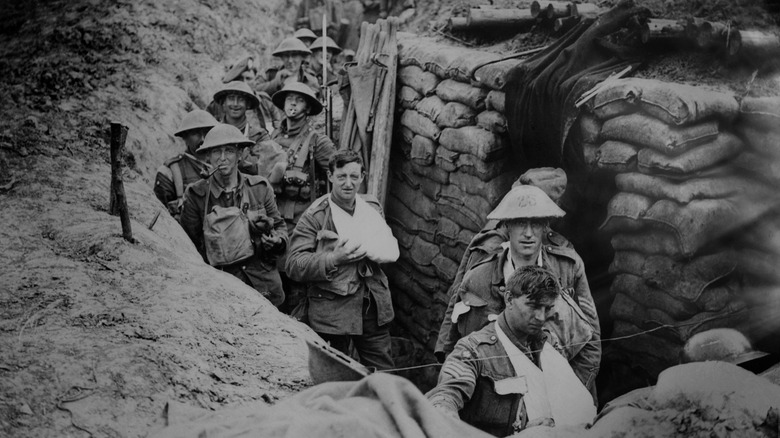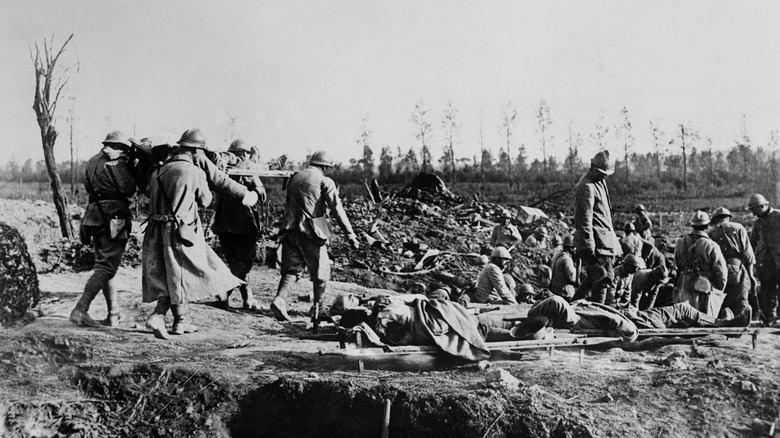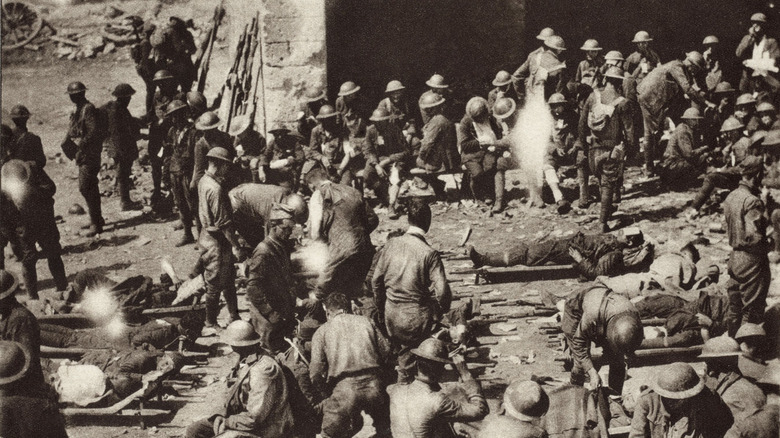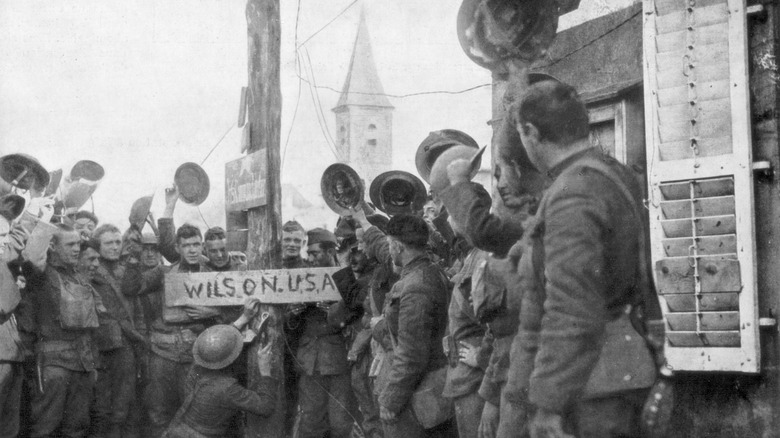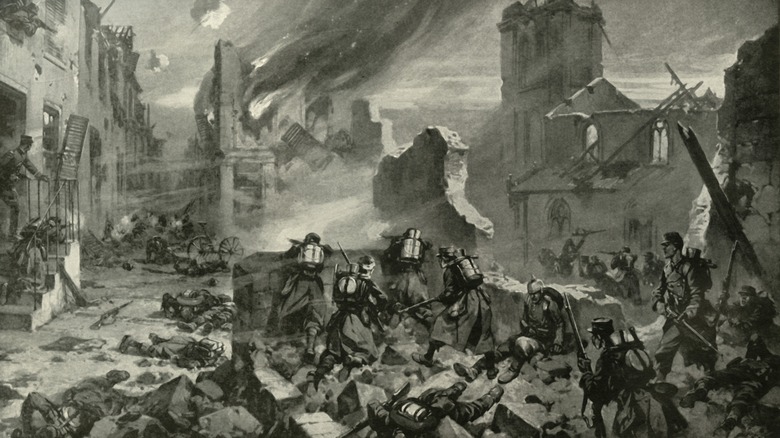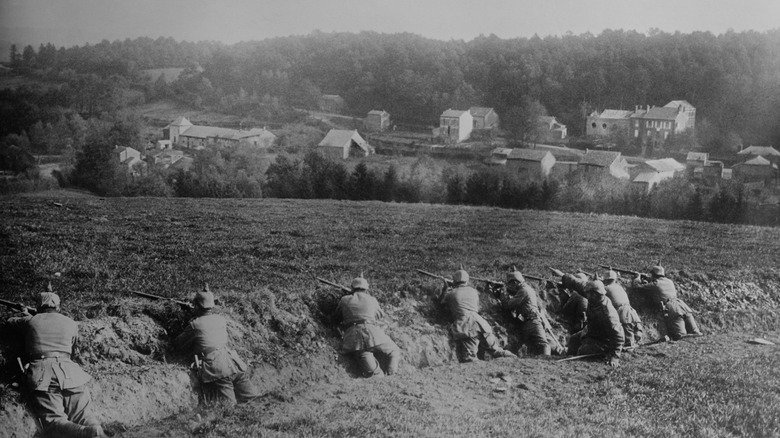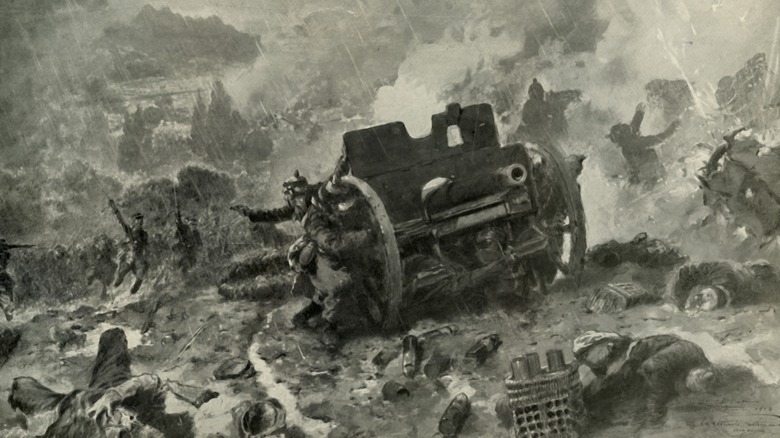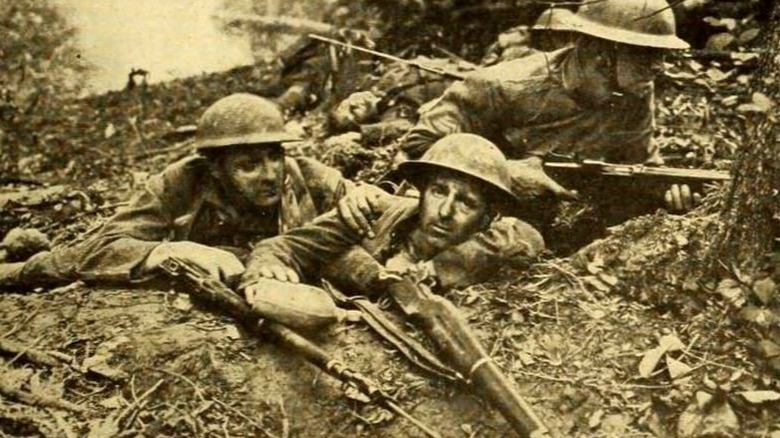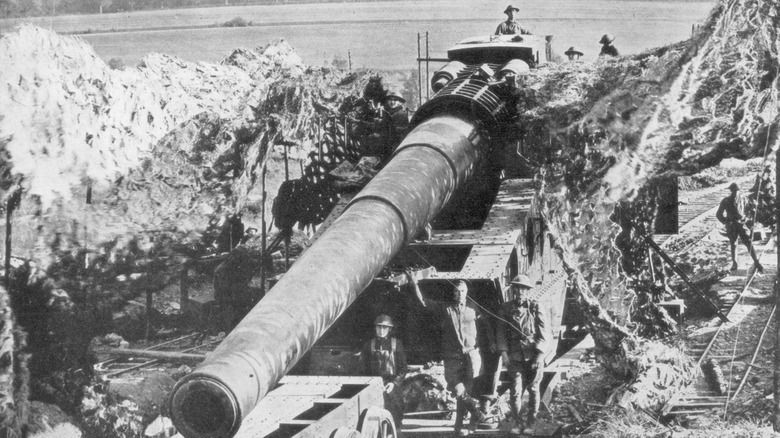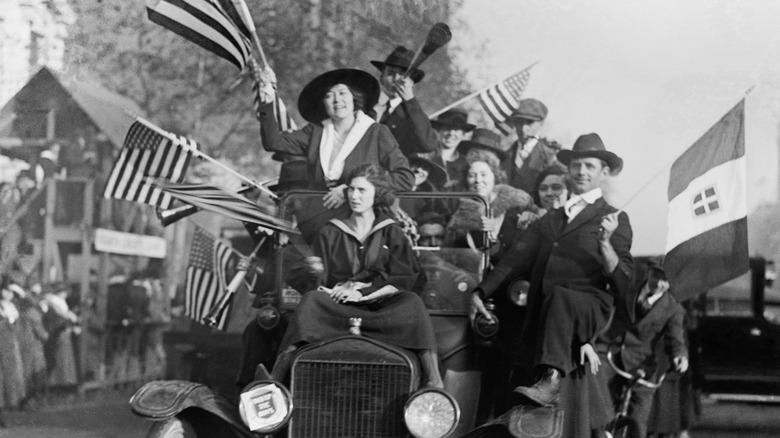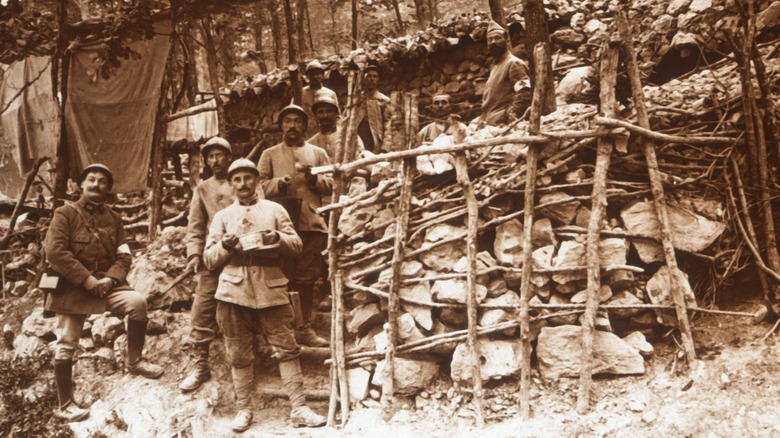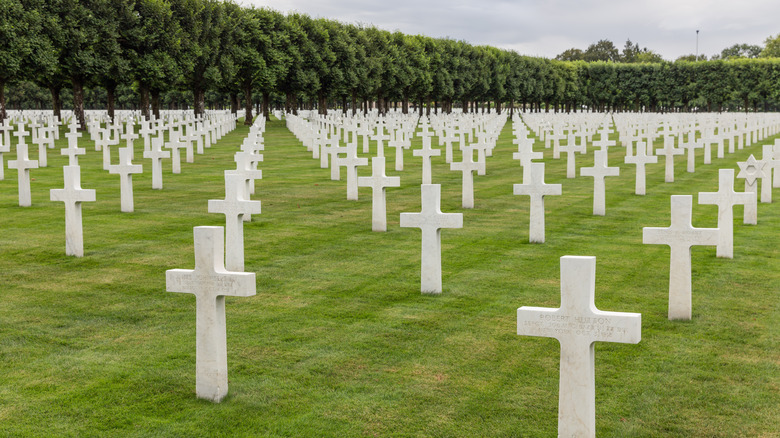The Battle Of Argonne Forest: The Deadliest American Battle In WWI
Masses of inexperienced soldiers — most of whom had barely tasted adulthood (per The Washington Post) — were sent to the Western Front during World War I (via International Encyclopedia of the First World War). Known as "The Great War," soldiers thought they would return home within weeks (via Delaware.gov). Yet, what became known as one of the most devastating wars in human history raged on for over four gruesome years. According to History, it was all triggered by a murder — the assassination of Austria-Hungary's Archduke Franz Ferdinand, and his wife Sophie, by a Bosnian Serb nationalist on June 28, 1914.
This lit the powder keg of war for nearly half a decade, resulting in over 20 million deaths internationally — including 9.7 million documented military personnel and 10 million civilians — as well as 21 million wounded, reported by Reperes. The Allies — composed of Russia, France, Belgium, Great Britain, and later Japan, Romania, China, and the United States — lost about 5.7 million forces, while the Central Powers (Bulgaria, the Ottoman Empire, Austria-Hungary, and Germany) lost about 4 million. So while the Allies "won" the battle, they returned home with more wounds to lick than the enemy. Still, they tasted victory on the Western Front time and time again, including a battle seldom discussed that involved a vast forest, plenty of mud and blood, and a particularly heroic pigeon that saved over a hundred men (via The United States World War One Centennial Commission).
The inexperienced experience the terrors of war
World War I was a conflict unlike any soldiers had ever seen. Of course, it would have helped if they had seen any battle before that (via The Washington Post). Like lambs to the slaughter, Macquarie University states that over 70% of the United States forces were wet-behind-the-ears new recruits, with over half of them being between the ages of 18 and 23. And a war as putrid as "The Great War" was an unforgiving start. World War I is in part remembered for its hygienic fouls, which resulted in a plethora of diseases (via Delaware.gov). Due to brutal trench warfare, soldiers were often trudging through increased moisture, mud, and even human waste. With this came diseases like trench foot — caused by prolonged moisture in boots — and trench mouth, a nasty form of gingivitis caused by increased bacteria resulting in painful mouth ulcers (via Mount Sinai).
According to the International Encyclopedia of the First World War, these trenches — marked by barbed wire and the stench of death — sat on either side of what was considered "No Man's Land." This area between enemy lines was exactly what it sounds like — a battleground raining with artillery where no man could be found, aside from the bodies of the dead. If caught in No Man's Land, a soldier's only saving grace was "pill boxes" — little cement huts meant as a temporary shelter from enemy attacks, as explained by the Army Heritage Center Foundation.
By the time the Battle of Argonne Forest rolled around in 1918, soldiers on the Western Front had already seen their share of hell.
Battle on the Western Front
The Guardian once explained how the battles on the Western Front were some of the most gruesome in the war, and yet, regardless of World War I quite literally taking place all over the world, the battles here were some of the most decisive (via International Encyclopedia of the First World War). The Western Front comprised about 400 miles of French and Belgian land — spanning all the way from Switzerland, up to the North Sea near the United Kingdom.
Countless battles were fought here, primarily between French, American and British forces, and the Germans. Some of these include the very first battle fought in the region — The Battle of Frontiers in August 1914 between German and French forces (which caused the allies to retreat) — and one of the last, The Second Battle of Marne. In The Second Battle of Marne, all four countries went at it, resulting in over 288,000 shared deaths — with those most devastated being the Germans, at 168,000, and the French, at 95,000. But there was still another battle to come that was nearly as bloody as this — the Battle of Argonne Forest, a battle that arguably, put an end to fighting on the Western Front, according to The National WWI Museum and Memorial.
Tensions rise in France
The Western Front was littered with ongoing battles, from the very start of the war (via The Guardian) until 1918, when The Battle of Argonne Forest occurred in France (via History Central). Just before this battle — which commenced around September 26 — the Americans and Germans were (again) at war in the same area. Between September 12 and September 16, 1918, the Allies battled with the Germans to infiltrate their lines into an area known as Saint Mihiel, where they seized over 8,000 prisoners and nearly 450 guns. American troops also fought to secure the nearby supply hub of Sedan, but that victory came soon after.
The Germans, however, did a fair share of damage to the Allied forces on the Western Front before this — particularly in France. In one battle three years earlier — dubbed the Battle of Loos — British troops turned about 5,100 cylinders of chlorine gas onto the Germans, yet the Germans still managed to kill 50,000 British with just machine guns (and German losses at about half of that). When given the advantage or high ground, German troops seldom released it during World War I; and the high ground is exactly what they had in the Battle of Argonne Forest.
The Battle of Argonne Forest was a bloodbath
Over 1 million American troops – most of them inexperienced (via The Washington Post) – participated in one of the largest operations in the war by the American Expeditionary Forces, according to National Archives. The Battle of Argonne Forest, which was part of the larger Meuse-Argonne Offensive set forth by the Allies, sought to clear Argonne Forest in France and occupy nearby Sedan, which was currently occupied by Germans (via History Central). The Army Heritage Center Foundation states that the battle commenced on September 26, 1918, but did not cease until November 11, after a muddy and bloody battle, blanketed with wet weather conditions and excessive death.
In the end, the Allies reached their goal — their forces did, after all, far outnumber the German troops — but it was only after ample bloodshed, as Germany held the high ground for most of the battle. A particularly treacherous battle for the Americans resulted in what could arguably be called a Pyrrhic victory, with 192,000 casualties, including 26,000 deaths. The French had about 70,000 casualties of all kinds, while the Germans' total of 126,000 included the 56,000 soldiers taken prisoner.
The location was a logistical necessity for the Germans
The Germans used their high ground not only as a military tactic — by raining artillery down on the enemy that they had a clear view of; they also used it to maintain occupancy in Sedan, according to the Army Heritage Center Foundation. Germany maintained occupancy of the city, about 80 miles from Paris near the Belgian border, for much of the war. They used it as an ammunition and supply hub, but it was also a mouth for one of the most major railways in Northern France, which they used to transport goods and weapons.
The Germans issued about 250 cargo trains a day — packed to the brim with ammunition, goods, and weapons — to their troops across the Western Front using this railway. Needless to say, for the Allies, occupying Sedan was a dire step in the advancement of the overall war and regaining control. So while the goal of the Meuse-Argonne Offensive for the Americans was to gain control (via History Central), the German goal was to maintain it. The latter forces fought tirelessly to do so, but they still lost (via Army Heritage Center Foundation).
The first attack
Under the guidance of General John Pershing, American troops — albeit inexperienced and young (via The Washington Post) – started with their first initiative on September 26, 1918, around 5 a.m. — a 3-hour-long frontal artillery bombardment that they used as a distraction to push deeper into German territory. Their overwhelming numbers put pressure on the enemy, pushing them farther and farther away from their original position: The American forces pushed the German troops back nearly 30 miles over the course of the battle, through the muck and mud blanketing the treacherous terrain of Argonne Forest (via Army Heritage Center Foundation).
In just the first month of the battle, the Allies captured around 9,000 prisoners and tons of equipment and weapons. By October, both militaries were bolstering their troops by calling in reinforcements, and while the Germans still maintained the high ground, the Americans issued another frontal attack on October 4. (According to The United States World War One Centennial Commission, around this time, the Americans also lost an entire battalion of troops to a tactical error in the French forest — but more on that later.)
By the end of October, the Americans had cleared the entirety of the forest and were getting ready for the second phase of their attack strategy.
The Lost Battalion
America's speedy advancement in the Battle of Argonne Forest (via Army Heritage Center Foundation) was too fast for some, per The Washington Post. Around 554 soldiers — most of them young and inexperienced — advanced too far behind German lines and were stuck there. They are now remembered as "The Lost Battalion," but many consider this a misnomer as they were not truly lost; they were abandoned. Soldier Samuel Marcus left behind a diary entry stating, "nothing can ever seem hard to me after what I have gone through."
They stayed there for about a week, October 2 to October 8, 1918, via The United States World War One Centennial Commission. Per the same source, they were cornered by German troops — beyond radio access — with only messenger pigeons at their disposal, which kept being shot down. They had no supplies, and artillery was raining down on them — both German and American (unknowingly). The majority of them died, and in dire straits, they released their last messenger pigeon, one named Cher Ami. The battalion's very last chance for survival, Cheri Ami flew through the wreckage — suffering major injuries — and delivered a note to American troops reading, "We are along the road parallel to 276.4. Our own artillery is dropping a barrage directly on us. For heaven's sake, stop it." Because of this, 194 of the original 554 managed to be saved.
The second attack
Despite the disaster of the Lost Batallion, the Allied Forces (specifically the Americans) were likely already sensing victory by the time the battle of Argonne Forest had been grinding on for a month. However, they never expected this one operation of many — over the course of four years on the Western Front — to end it all (via Army Heritage Center Foundation). And much quicker than the first phase, the second phase of the battle of Argonne Forest concluded in a matter of days.
By November 1918, the Americans had pushed even further, gained more ground, issued more attacks, and were drawing nearer to the logistical hub of the German military in the area, the French town of Sedan. By November 1, they had reached the Meuse River, and by November 4, they were at the outskirts of Sedan. By November 10, the Americans had officially taken over Sedan, per Britannica.
The invasion was already devastating to German troops — who were internally mutinying at the loss (via History Central) — but the Americans also cut off their railway access, their lifeline and only remaining stake in the Western Front.
The Armistice finally arrives
History reports that while World War I did not officially come to end until the Treaty of Versailles was signed a year later in 1919, the Battle of Argonne did result in the end of true warfare on the Western Front (via The National WWI Museum and Memorial). Once the Allies gained control over Sedan and the Germans began mutinying (via Britannica), all sides agreed to come together to sign the Armistice on the Western Front on November 11, 1918 — a day after the Sedan railway was overtaken (via National Museum of the U.S. Navy). It was signed pretty informally, in a railway car at 5 a.m. in Compagnie, France. The car belonged to Marshall of France Ferdinand Froch, but those inside included other Allies and German troops, who agreed to a ceasefire across the entire Western Front.
While fighting still continued elsewhere until the official end of World War I in 1919, troops on either side rejoiced — despite their heavy losses, per The National WWI Museum and Memorial. One American military man, Robert Casey, said he could hear cheering from either side of the river. "And this is the end of it. In three hours, the war will be over. It seems incredible as I write it ..." he said. However, he also described apathy, grief, and denial among the troops. "For the most part, though, we are in silence ... with all is a feeling that it can't be true. For months we have slept under the guns ... we cannot comprehend the stillness."
The Battle of Argonne Forest helped bring the war to an end
The Battle of Argonne Forest certainly is not one of the most well-known battles fought in Europe by the Americans, with much more famous strifes like the Normandy Invasion (a.k.a. D-Day) of World War II. Yet, the bloodshed Argonne Forest saw was just as brutal, with over 192,000 American casualties and 26,000 deaths, according to History Central, as opposed to D-Day, with 135,000 American casualties and 29,000 deaths, per Britannica.
Much like D-Day though — which was a start to Allied operations against Nazi rule, eventually bringing freedom to Western Europe (via The D-Day Story) — the Battle of Argonne Forest took control back from the Germans and issued an end to World War I as it was known for over four years (via The National WWI Museum and Memorial). Still, as illustrated so poignantly by the disaster of the Lost Battalion, as the Washington Post explains, war is brutal, and not every act seen at the Battle of Argonne Forest was heroic, and sadly, not everyone who could have been saved was.
The end of World War I
After all the bloodshed, death, disease, and traumatic experiences that marked the Battle of Argonne Forest — such as the loss of over two-thirds of "The Lost Battalion" (via The United States World War One Centennial Commission) — the first step in ending World War I was the signing of the Armistice on the Western Front (via National Trust). Then, came the Treaty of Versailles — exactly five years after the assassination of Archduke Franz Ferdinand that started it all, per History. According to National Geographic, it was signed on June 28, 1919, in the Palace of Versailles outside Paris, and it called for an overall end to "The Great War," which plagued the world for over four years (via Delaware.gov).
World War I changed the modern world as we know it, triggering the collapse of the Austro-Hungarian Ottoman Empire, and igniting flames of international tension for years to come, per The Washington Post. Also true, the Battle of Argonne Forest changed World War I as the soldiers knew it, bringing an end to the heartache, especially for those young men who were conscripted away from their families, under the impression they would only be fighting for weeks. Now, visitors can pay tribute to the fallen in Romagne-sous-Montfaucon, France, at the Meuse-Argonne American Cemetery, which rests the largest number of military in Europe (via American Battle Monuments Commission). There are a total of 14,246 graves across 130.5 acres there, most of whom died during that fateful fall in Argonne Forest.
